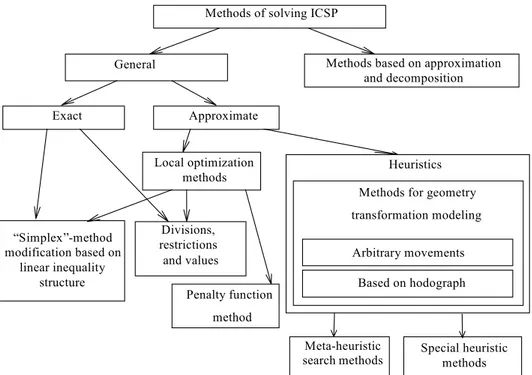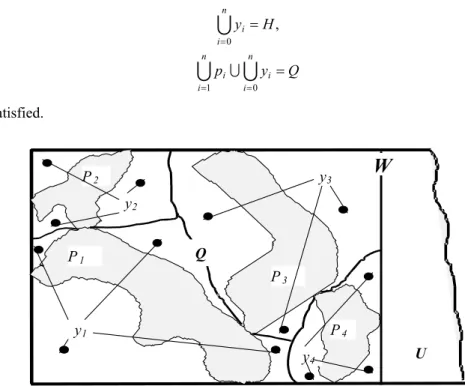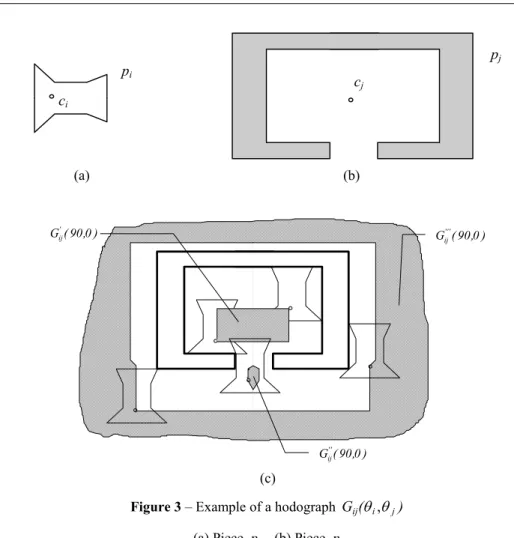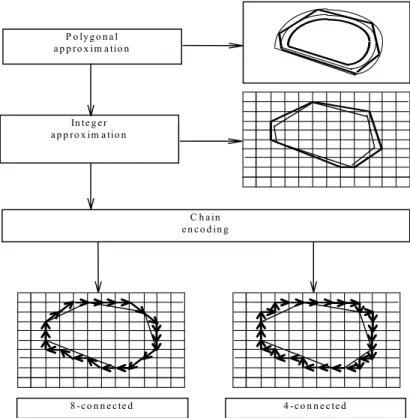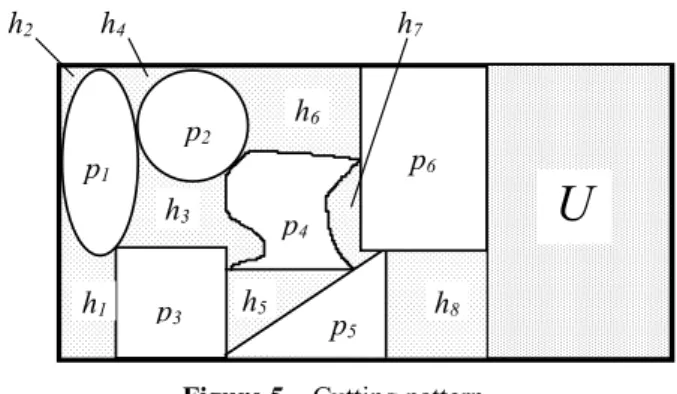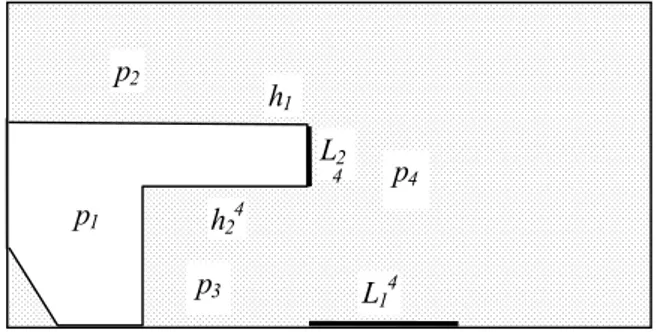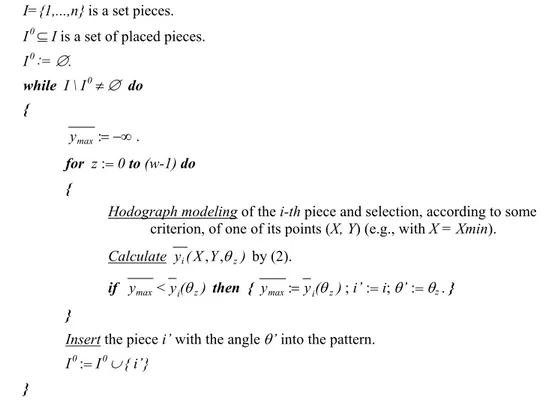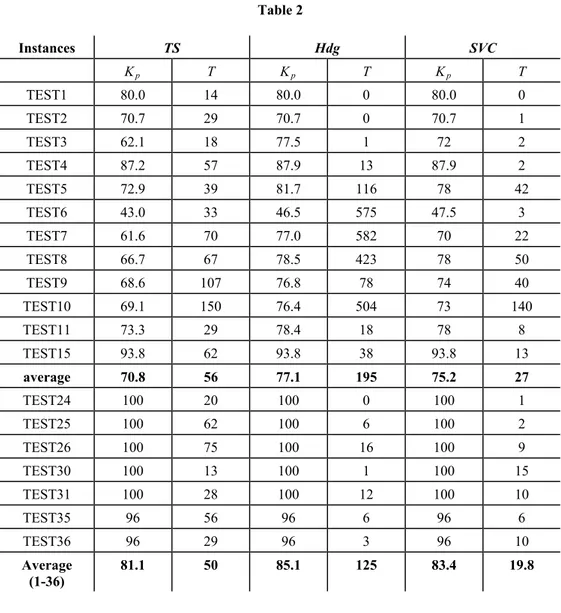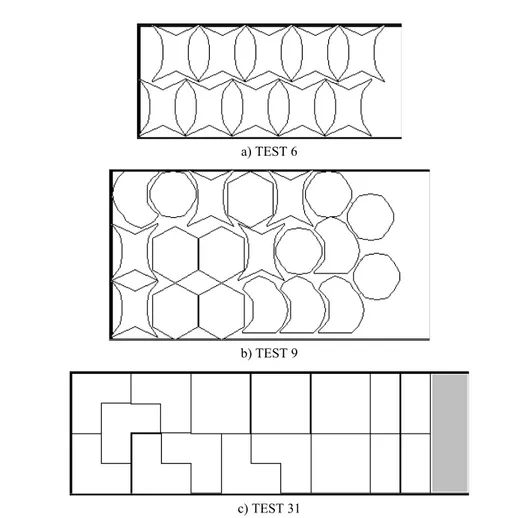THE SEQUENTIAL VALUE CORRECTION METHOD FOR THE TWO-DIMENSIONAL IRREGULAR CUTTING STOCK PROBLEM
M.A. Verkhoturov O.Y. Sergeyeva
Ufa State Aviation Technical University Ufa, Russia
Abstract
This paper regards the problem of the two-dimensional irregular cutting stock problem (ICSP), where the pieces to be cut out may be of any shape. The sequential value correction method has been developed to solve this problem. This method is based on dual values (variables), which is the essential concept of linear programming. We suggest a technique of value calculation for such pieces. The algorithms are included. We also describe a computing experiment whose results are the evidence of the good performance of the algorithms developed.
Keywords: irregular cutting stock problem; nesting; heuristics; hodograph.
1. Introduction
The two-dimensional irregular cutting stock problem may be applied in a number of industries, including clothing industry, shoe-leather cutting, furniture industry, aerospace industries, machine-building, etc. The problem under investigation is as follows: a set of 2D-pieces of irregular shape is to be placed on a given area of a stock-material with minimum of trim-loss. The most common technological limitation here concerns permissible rotation angles of the pieces. Permissible placement of wanted pieces on stock-material is called cutting pattern. The cutting pattern has no overlaps of the pieces and meets all technological requirements. The quality of a cutting pattern is determined by the cutting ratio, which is defined as the ratio between the total area of the placed pieces and the total area of the stock-material.
See Figure 1 for the classification of solution methods.
“Simplex”-method modification based on
linear inequality structure
Methods of solving ICSP
General Methods based on approximation
and decomposition
Exact Approximate
Local optimization methods
Divisions, restrictions and values
Heuristics
Penalty function method
Meta-heuristic searchmethods
Special heuristic methods Methods for geometry transformation modeling
Arbitrary movements Based on hodograph
Figure 1 – Solution method classification of ICSP
The method based on approximation and decomposition is a widespread solution method for complex problems in many fields of knowledge. This method reduces the problem to solution of one or, sequentially, several simple problems. This method can be used for solving ICSP as well. The simplest method here is approximation of every piece (or several pieces) from the initial set by a geometrical object (objects) which can be easily placed on the stock-material without overlapping, Adamovicz & Albano (1976).
However, most of the real-world ICSP deal with pieces of arbitrary configurations. In this case, there are substantial material wastes and the method in question is not always effective. Problems of this class are generally solved based on the actual shape of pieces. The principal classification of solution methods for such problems is done with respect to the optimization degree. The problems class is regarded as NP-hard. If rotation of pieces is forbidden, we may solve ICSP by global optimization methods. However, even for this problem the exhaustive search appears too involved to yield exact solution within acceptable time. These methods are therefore mainly a theoretical achievement.
For real-world tasks, approximate and heuristic methods are used, which are both most wide-spread and most intensively developed.
Exact methods are based on linear programming concepts and methods, Novogilova (1988), Milenkovic (1996).
In approximate methods, both linear programming methods and non-linear programming methods, Ivanov (1993), may be used. These help to find local optima and to arrange among exhaustive search of extreme values of the goal function.
Another set of methods for approximate solution contains heuristic algorithms. These methods search for admissible (near-optimal) cutting patterns. They are well-established solution methods for NP-hard problems, Papadimitriou & Steiglitz (1985). Their distinctive feature is that at each simple step they operate as a rule individual pieces (piece-by-piece placement method), transforming their geometry. These transformations may be of two types:
• Arbitrary shifts and rotations permitting overlap of pieces;
• Shift transformation of pieces, for which a piece, at each subsequent point of the path, remains contiguous with pieces formerly placed and/or stock-material (these transformations are based on the notion of hodograph, Stoyan & Gil’ (1976)).
Among the variety of heuristic methods note the most frequently used meta-heuristic methods such as “simulated annealing” (SA) (e.g., Heckmann & Lengauer (1995)), “genetic algorithm” (GA), “tabu search” (TS) (e.g., Blazewicz et al. (1993)) and special heuristics (e.g., Verkhoturov (1997)).
The present paper discusses the method of piece-by-piece placement, based on the notion of hodograph, combined with the method of sequential value correction.
2. Problem Formulation
We have the stock-material W and the set of 2D-pieces, P = {p1,…,pn}. Denote the arbitrary fixed point on the piece pi as the center ci. The cutting pattern is the mapped stock-material W with pieces pi, i = 1,…, n that satisfy the following conditions:
∅ = ∩ j
i p
p
i
i W p
p ∩ = , . Let S(x) be the area of the piece x. It is also assumed that
∑
= >> n i
i) p S( )
W S(
Divide the cutting patterns into two parts: the part U and its occupied part Q, so that Q = W \ U. Distribute the trim-loss H of Q among the pieces pi, i = 1,…, n and the outside
0 ,i=
Q of the stock-material into parts yi, i = 0,1,…, n such that the following conditions (Figure 2): , ∅ = ∩ j i y y , 0 H y n i i = =
∪
y p n i i n i = = =∪
∪
∪ 0 1 Q i are satisfied. P1 P2 P3 P4 y1 y2 y3 y4W
U QFigure 2 – Cutting pattern (without y0)
The goal function is described by:
min ) y S( ) H S( n i i → = =
∪
0 .Our aim is to minimize the trim-loss of the stock-material.
The quality of the cutting pattern is determined by the a cutting ratio Kp :
) Q S( ) P S( Kp = ,
where
∑
= = n i i) p S( ) P S( 1 .cj ci
pi
pj
(a) (b)
) 0 , 90 ( G'''
ij ) 0 , 90 ( G''
ij ) 0 , 90 ( G' ij (c)
Figure 3 – Example of a hodograph Gij(θi,θj)
(a) Piece pi (b) Piece pj
(c) The shaded area shows parts of the hodograph Gij(90,0)
Under the hodograph Gij(θi,θj) of the piece pi with respect to the piece pj we understand such a set of positions of the center ci in the piece pi rotated at an angle θi , for which the pieces pi and pj do not intersect in their inner points; note that the piece pj is rotated at an angle θj to satisfy that
∅ = ) ( p int ) ( p
int iθi ∩ jθj .
Minkowski operations, Serra (1982), allow us to define the hodograph Gij(θi,θj)as ) c ) ( (p ) ( p ) (
Gij θi,θj = j θj ⊕− iθi / i .
} B b A a b a { B
A⊕ = + | ∈ , ∈ is the Minkowski sum of two sets, A and B; } B b A a b a { B
A/ = − | ∈ , ∈ is the Minkowski difference; A
R
A= 2\ is the set complement of A to R ;2 }
A a a {
A= − ∈
For the piece pi rotated at an angle of θi , the hodograph relative to the stock-material W is determined in a similar manner:
) c ) ( p ( W ) (
GiW θi = ⊕− i θi / i
Generally, the hodograph may consist of several parts (see Figure 3), and incorporate separate segments or their aggregates (given dense nesting), as well as separate points.
3. Representation of Information and Model Hodograph
In order to describe the pieces and the stock-material, we resort to our earlier suggested method of discrete-logic representation and chain encoding, Verkhoturov (1992). This method is essentially multi-stage approximation (see Figure 4). The first stage involves a polygonal approximation of the piece contour represented by linear and arc segments. Next, the polygon is approximated by another polygon whose tops have integer coordinates. At the last stage, the polygon with integer coordinates is replaced by chain codes (four- or eight-connected, Pavlidis (1982)). Chain encoding facilitates construction of the hodograph since all calculation is in fact cut down to logical operations over nulls and units. This is especially important when using a computer.
These questions are considered in the article, Verkhoturov & Sergeyeva (1992, 1996), more detailed.
P o ly g o n a l a p p r o x im a tio n
In te g e r a p p r o x im a tio n
C h a in e n c o d in g
4 - c o n n e c te d 8 - c o n n e c te d
4. Method of Sequential Value Correction
At present, no exact algorithms of polynomial complexity exist for NP-hard problems. The method of SVC has been effectively used as the ground for building approximate polynomial solution algorithms for some NP-hard cutting and packing problems, Mukhacheva & Zalgaller (1993). It has also been chosen to solve a sub-problem of the external optimization level, namely, that of the order of sequence of the pieces to be arranged, and the problem of 2-D pieces packing.
First, we focus on the values properties and the principles of SVC.
Based on a certain permissible cutting pattern, we calculate the material consumption rates for each piece and assume them to be the values, . These values are fully consistent within the problem formulation. Their role is analogous to that of dual variables in linear programming problems as they serve to test the permissible cutting pattern for optimality, and also to generate new cutting patterns. The method proposed is an iteration process that at each step recalculates the values to fit each next cutting pattern. The values allow us to determine the exhaustive search order for combinations of pieces; the search is done according to the priority list wherein pieces have been arranged in the order of decrease of specific values . This method was developed by the students of Prof. E. Mukhacheva and was applied to guillotine cutting optimization under the name of SVC.
) y p S( yi' = i∪ i
) p S( y yi*= i'/ i
The SVC method was further used for solving rectangular and parallelepiped packing problems.
The effective value-based optimization formalism may also be applied to pieces of irregular shape. In this case, as with integer linear cutting, the physical meaning of dual variables must be taken into account. In what follows, we consider the calculation method for pieces values and the optimization schemes based on the above ideas.
p4
p3 p1
h3
p5 h5
p6 h6
h1
h2 h4 h7
h8
U
p2
Figure 5 – Cutting pattern
Suppose we have a cutting pattern with a trim-loss H (see Figure 5). This cutting pattern contains a set of pieces, P={pi}i=1,n, and a set of unoccupied parts (trim-loss), H={hj}j=1,m (n=6, m=8 in Figure 5). sv and lv ( ) are the area and the perimeter of the i-th piece or the j-th unoccupied part, respectively. It is convenient to regard the outside of the area
} , {i j v=
Q
∑
∑
= = = n i i m jj) S(y ) h
S(
0 1
. We must cut m unoccupied parts hj into (n+1) values yi between n pieces pi and the outside of the placement area, Q.
} 0 i { I Ie⊂ 0∪ ,
Let I j ⊂ I ∪ {0} be the set of pieces that define the j-th unoccupied part and lij a segment of the perimeter pertaining to the i-th piece, i ∈ I j
. The value y’i, is then determined as:
} { , 1 ' 0 I i ) l l s ( s y m j j ij j i
i= +∑ × ∈ ∪
= (1)
The essence of the formula is that the value of piece y’i is equal to its area si plus: from the area of each unoccupied part sj around the piece pi , such part is taken that is proportional to the segment of the perimeter of the unoccupied part, which is formed by the piece –
j ij l l
.
Consider now the procedure for determining every next piece to be arranged. Let Q(I 0) be a partial cutting of pieces in a set I 0. We assume that the position of each piece to be arranged with the fixed angle θ k in the cutting area, i ∈ I \ I 0 (X,Y being the pole coordinates), is uniquely defined by the hodograph modeling procedure. The number of permissible rotations is fixed at w which is the multiple of ∆θ : θ0 = 0, θ1 = ∆θ, θ2 = 2∆θ,..., θw-1 = 3600 –∆θ.
p2
h24
p4
h1
L2 4
L14
p3
p1
Figure 6 – Allocation of a new piece
The placement of the piece i ∈ I \ I 0
leads to mi new unoccupied parts, hij, and ri edges, , shared by the piece i with the packed part of the area (see, for instance, the placement of the piece p
i e L
4 in Figure 6, where we have m4 = 2 for h14 and h24, and r4 = 2 for and ). Let I 4 1 L 4 2 L j ⊂ I 0 ∪ {i,0} be a set of pieces that define the area j∈ {1,...,m
i } (for j=1 – I 1={1,2,4}) and ) a pair of pieces that define the edge e∈ {1,...,ri} (for e=1 – I 1={0,4}). Then for each next piece to be placed, the value of
, 1 1 ' 1 ' ∑ − × + × = = = ∈ = ∈
∑ ∑
∑ ∑
i ie i j m j j r
e k I k e k m
j k I k kj k z i s l l y l l y ) (
y θ (2)
The next piece to be placed, i’, is chosen such that the angle θ’ corresponds to the maximum value of yi(θz). This is analogous to the choice of a piece with such a rotation angle that, being placed in the placement area, this piece (i) forms mi unoccupied areas hij , each of which encompasses a set of such I j pieces that have had large values at the previous iteration (the 1
' k y st
item in (2)); (ii) has larger le , ri that share rib parts with surrounding pieces (the 2nd item in (2)) and (iii) forms unoccupied areas hij , j ∈ {1,...,mi } with minimum total area (the 3rd item in (2)).
5. Algorithms
The SVC-method algorithm may be represented as three algorithms: the outer (SVC) and the inner (Pattern Cutting and FFD) algorithms.
SVC Algorithm
Generate the initial cutting pattern M1 with H=H1. (FFD Algorithm). k:=1; smin:= S(H1); Mopt := M1
Analyze the obtained cutting pattern M1
while “Condition of algorithm continuation”=TRUEdo {
Calculate values y'i , i∈ I according to (1). k:=k+1.
Generate k-th current cutting pattern Mk (Algorithm Pattern Cutting).
if S(Hk)<smin then { Mopt := Mk; smin := S(Hk). }
}
FFD Algorithm
Formation of the priority list PL[n] with decrease of the areas of pieces
for i :=1 to n do {
lmin := ∞.
for z := 0 to (w-1) do {
Hodograph modeling PL[i] -th piece and selection of its point (Xmin, Y).
if lmin>Xmin then { lmin := Xmin ; Y ' := Y; i ’ := PL[i]; θ’ := θz . }
}
Insert the piece i ’ with the angle of rotation θ’ into the point (lmin,Y ') of pattern.
Algorithm Pattern Cutting generates a new cutting pattern based on the calculated piece values:
Pattern Cutting Algorithm
I={1,...,n} is a set pieces.
I0 ⊆ I is a set of placed pieces.
I0 := ∅.
while I \ I0 ≠ ∅ do {
−∞ =
:
max
y .
for z := 0 to (w-1) do {
Hodograph modeling of the i-th piece and selection, according to some criterion, of one of its points (X, Y) (e.g., with X = Xmin). Calculate yi(X,Y,θz) by (2).
if ymax<yi(θz) then { ymax: =yi(θz); i’ := i; θ’ := θz . }
}
Insert the piece i’ with the angle θ’ into the pattern. I0 := I0 ∪{ i’}
}
6. Experimental Results
35 examples of cutting problems taken from literature and practice were used to evaluate the efficiency of algorithms. The SVC algorithms were compared with one another and also with two additional algorithms of random search (randomly generated sequence of pieces on the priority list) (RS) and fixed PL evaluation (with pieces put on the list in the order of specific value decrease) (FPL). Experiments were conducted on an IBM PC Pentium 100 MHz. The results were assessed after 100 iterations for RS and FPL, and after 40 iterations for SVC. Comparison of SVC with RS and FPL algorithms gives us the following results. Solutions produced by SVC were better in 93% examples as compared with RS, and 89% examples as compared with FPL.
The temporal characteristics of algorithms are presented in Table 1.
Table 1
Tmin per 1 It
(sec.)
Tmax per 1 It
(sec.)
Taverage per 1 It
(sec.)
Tbest
(sec.)
Algorithms RS, FPL 1 17 4 430 (100 It.)
Some more examples of algorithms taken from literature were also used for comparison. The method called tabu search (TS) was proposed by Blazewicz et al. (1993), for calculating efficient packing of 2-D pieces, and calculation results were reported. We used many examples reported by these authors for comparison of SVC with TS and also with the hodograph algorithm (Hdg), proposed by Heckmann & Lengauer (1998). Results of comparison are given in Table 2. Kp stands for the cutting ratio (per cent), T is the count runtime (s) until a better solution is produced. TS and SVC calculations were done on an IBM-PC while R. Heckmann employed the SPARC-ULTRA workstation. The table shows that solutions generated by SVC are practically always better than those by TS, but 1.7% worse than those by Hdg.
Table 2
Instances TS Hdg SVC
Kp T Kp T Kp T
TEST1 80.0 14 80.0 0 80.0 0
TEST2 70.7 29 70.7 0 70.7 1
TEST3 62.1 18 77.5 1 72 2
TEST4 87.2 57 87.9 13 87.9 2
TEST5 72.9 39 81.7 116 78 42
TEST6 43.0 33 46.5 575 47.5 3
TEST7 61.6 70 77.0 582 70 22
TEST8 66.7 67 78.5 423 78 50
TEST9 68.6 107 76.8 78 74 40
TEST10 69.1 150 76.4 504 73 140
TEST11 73.3 29 78.4 18 78 8
TEST15 93.8 62 93.8 38 93.8 13
average 70.8 56 77.1 195 75.2 27
TEST24 100 20 100 0 100 1
TEST25 100 62 100 6 100 2
TEST26 100 75 100 16 100 9
TEST30 100 13 100 1 100 15
TEST31 100 28 100 12 100 10
TEST35 96 56 96 6 96 6
TEST36 96 29 96 3 96 10
Average (1-36)
81.1 50 85.1 125 83.4 19.8
a) TEST 6
b) TEST 9
c) TEST 31
Figure 7 – Some cutting patterns, obtained by SVC-method on test examples by J. Blazewicz
7. Summary
The paper investigates the possibilities for adapting the method of sequential value correction to irregular cutting stock problems. This method proves competitive for linear and rectangular cutting problems. It is used for solving ICSP in combination with geometry transformation modeling method based on the hodograph notion. The idea of evaluation is analogous to that of dual values found in linear programming problems; in cutting problems, dual values denote material consumption rates per detail. We suggest the method of values count for irregular 2-D pieces. This method underlies the algorithm generated for the SVC-method. SVC as applied to ICSP gives up the fixed priority list used in linear and rectangular CSP in advantage of the ‘greedy’ strategy of its formation. The methods proposed are compared with the priority list formation methods based on the ‘random’ and ‘fixed-in-the-order-of-values-decrease’ principles, as well as with the ‘tabu search’ method by J. Blazevicz and the ‘hodograph’ method by R. Heckmann.
The quality of the results obtained by the methods based on the notion of hodograph depends to a large degree on the manner of its construction. In this paper, we employ the procedure based on representation of piece contours in the form of chain codes. The yield greatly depends on the level of approximation accuracy. The higher the discretization step, the better the quality of the yield is. We further intend to study this dependence in more detail. It also appears promising to investigate the approximation accuracy dependence of the count time and to develop a selection procedure for the best accuracy approximation.
References
(1) Adamovicz, A. & Albano, A. (1976). Nesting two-dimensional shapes in rectangular modules. Computer Aided Design, 8, 27-33.
(2) Blazewicz, J.; Hawryluk, P. & Walkowiak, R. (1993). Using a tabu search approach for solving the two-dimensional irregular cutting problem. Annals of OR, 41(1-4), 313-325. (3) Heckmann, R. & Lengauer, T. (1995). A simulated annealing approach to the nesting
problem in the textile manufacturing industry. Annals of Operations Research, 57, 103-133.
(4) Heckmann, R. & Lengauer, T. (1998). Computing closely matching upper and lower bounds on textile nesting problems. European Journal of Operational Research, 108, 473-489.
(5) Ivanov, G.A. (1993). Flat geometric object allocation projecting by non-linear programming methods: Autoref. Dissert...cand.techn.sc. – Ioshkar-Ola, 16p.
(6) Milenkovic, V.J. (1996). Translational Polygon Containment and Minimal Enclosure using Mathematical Programming Based Restriction. Proceedings of the 1996 ACM Symposium on the theory of Computing (STOC), May 22-24, 109-118.
(7) Mukhacheva, E.A. & Zalgaller, V.A. (1993). Linear Programming Cutting Problems. International Journal of Software Engineering and Knowledge Engineering, 3(4), 463-476.
(9) Papadimitriou, C.H. & Steiglitz, K. (1985). Combinatorial optimization, Mir, Moscow, 512p.
(10) Pavlidis, T. (1982). Algorithms for graphics and image processing. Computer science press, 400p.
(11) Serra, J. (1982). Image analysis and mathematical morphology, Academic press, New-York, v.1.
(12) Stoyan, Yu.G. & Gil’, N.I. (1976). Methods and algorithms of allocation of flat geometric objects, Naukova dumka, Kiev, 248p.
(13) Verkhoturov, M.A. (1992). Irregular cutting stock problem on base discrete logical representation. Thesis competing for a candidate degree of technical science, SATUU, Ufa, 147p.
(14) Verkhoturov, M.A. & Sergeyeva, O.U. (1996). Some specific details of the geometrical object packing realization based on chain coding. – Deciding under Conditions of Uncertainty, SATUU, Ufa, 70-78.
